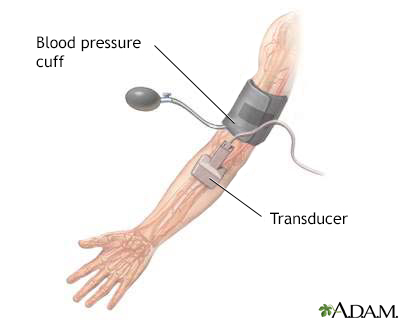Duplex ultrasound
Vascular ultrasound; Peripheral vascular ultrasound
A duplex ultrasound is a test to see how blood moves through your arteries and veins.
Images

I Would Like to Learn About:
How the Test is Performed
A duplex ultrasound combines:
- Traditional ultrasound: This uses sound waves that bounce off blood vessels to create pictures.
- Doppler ultrasound: This records sound waves reflecting off moving objects, such as blood, to measure their speed and other aspects of how they flow.
There are different types of duplex ultrasound exams. Some include:
- Arterial and venous duplex ultrasound of the abdomen. This test examines blood vessels and blood flow in the abdominal area.
- Carotid duplex ultrasound looks at the carotid artery in the neck.
- Duplex ultrasound of the extremities looks at the arms or legs.
- Renal duplex ultrasound examines the kidneys and their blood vessels.
You may need to wear a medical gown. You will lie down on a table, and the ultrasound technician will spread a gel over the area being tested. The gel helps the sound waves get into your tissues.
A wand, called a transducer, is moved over the area being tested. This wand sends out the sound waves. A computer measures how the sound waves reflect back, and changes the sound waves into pictures. The Doppler creates a "swishing" sound, which is the sound of your blood moving through the arteries and veins.
You need to stay still during the exam. You may be asked to lie in different body positions, or to take a deep breath and hold it.
Sometimes during a duplex ultrasound of the arteries of the legs, the health care provider may calculate an ankle-brachial index (ABI). You will need to wear blood pressure cuffs on your arms and legs for this test.
The ABI number is obtained by dividing the blood pressure in the ankle by the blood pressure in the arm. A value of 0.9 or greater is normal.
How to Prepare for the Test
Usually, there is no preparation for this test.
If you are having an ultrasound of your stomach area, you may be asked not to eat or drink after midnight. Tell the person doing the ultrasound exam if you are taking any medicines, such as blood thinners. These might affect the results of the test.
How the Test will Feel
You may feel some pressure as the wand is moved over the body, but there is no discomfort most of the time.
Why the Test is Performed
A duplex ultrasound can show how blood flows to many parts of the body. It can also tell the width of a blood vessel and reveal any blockages. This test is a less invasive option than arteriography and venography.
A duplex ultrasound can help diagnose the following conditions:
- Abdominal aneurysm
- Arterial narrowing (stenosis) or blockage (occlusion)
- Blood clot
- Carotid occlusive disease (See: Carotid duplex)
- Renal vascular disease
- Varicose veins
- Venous insufficiency
A renal duplex ultrasound can also be used after kidney transplant surgery. This shows how well a new kidney is working.
Normal Results
A normal result is normal blood flow through the veins and arteries. There is normal blood pressure and no sign of a narrowing or blockage of a blood vessel.
What Abnormal Results Mean
An abnormal result depends on the specific area being examined. An abnormal result may be due to a blood clot or plaque buildup in a blood vessel.
Risks
There are no risks.
Considerations
Smoking may change the results of an ultrasound of the arms and legs. This happens because nicotine can cause the arteries to shrink (constrict).
Related Information
UltrasoundDoppler ultrasound exam of an arm or leg
Blood clots
Venous insufficiency
Arterial embolism
Angioplasty and stent placement - peripheral arteries
Angioplasty and stent placement - peripheral arteries - discharge
Deep vein thrombosis - discharge
References
Bonaca MP, Creager MA. Peripheral artery diseases. In: Libby P, Bonow RO, Mann DL, Tomaselli GF, Bhatt DL, Solomon SD, eds. Braunwald's Heart Disease: A Textbook of Cardiovascular Medicine. 12th ed. Philadelphia, PA: Elsevier; 2022:chap 43.
Kremkau FW. Principles and instruments of ultrasonography. In: Pellerito JS, Polak JF, eds. Introduction to Vascular Ultrasonography. 7th ed. Philadelphia, PA: Elsevier; 2020:chap 2.
Pascarella L, Marston W. Venous disease. In: Townsend CM Jr, Beauchamp RD, Evers BM, Mattox KL, eds. Sabiston Textbook of Surgery. 21st ed. St Louis, MO: Elsevier; 2022:chap 65.
Stone PA, Clark RM. Vascular laboratory: arterial duplex scanning. In: Sidawy AN, Perler BA, eds. Rutherford's Vascular Surgery and Endovascular Therapy. 10th ed. Philadelphia, PA: Elsevier; 2023:chap 22.
BACK TO TOPReview Date: 5/10/2024
Reviewed By: Neil Grossman, MD, Saint Vincent Radiological Associates, Framingham, MA. Review provided by VeriMed Healthcare Network. Also reviewed by David C. Dugdale, MD, Medical Director, Brenda Conaway, Editorial Director, and the A.D.A.M. Editorial team.

Health Content Provider
06/01/2025
|
A.D.A.M., Inc. is accredited by URAC, for Health Content Provider (www.urac.org). URAC's accreditation program is an independent audit to verify that A.D.A.M. follows rigorous standards of quality and accountability. A.D.A.M. is among the first to achieve this important distinction for online health information and services. Learn more about A.D.A.M.'s editorial policy, editorial process and privacy policy. A.D.A.M. is also a founding member of Hi-Ethics. This site complied with the HONcode standard for trustworthy health information from 1995 to 2022, after which HON (Health On the Net, a not-for-profit organization that promoted transparent and reliable health information online) was discontinued. |
The information provided herein should not be used during any medical emergency or for the diagnosis or treatment of any medical condition. A licensed medical professional should be consulted for diagnosis and treatment of any and all medical conditions. Links to other sites are provided for information only -- they do not constitute endorsements of those other sites. © 1997- 2025 A.D.A.M., a business unit of Ebix, Inc. Any duplication or distribution of the information contained herein is strictly prohibited.
